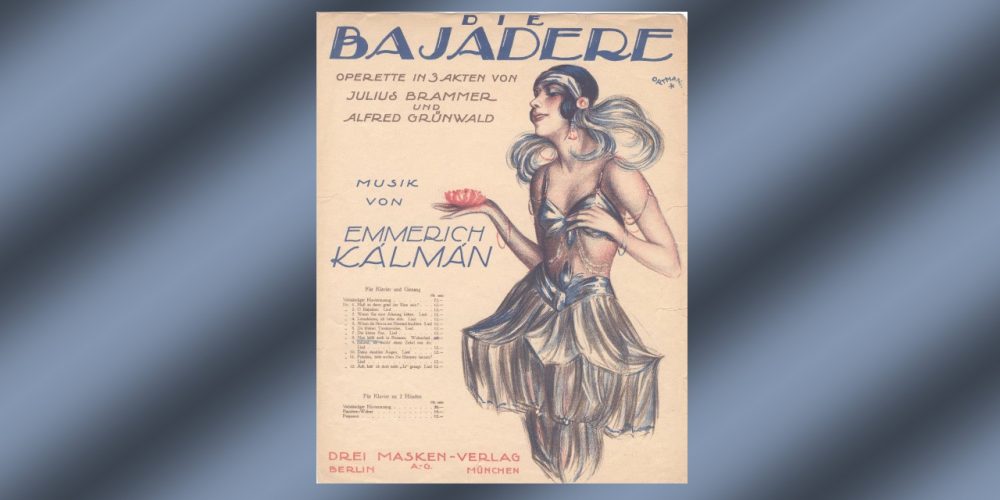Our story begins in the early 1920s in Soviet Russia when a teenaged Ayn Rand (then Alisa Rosenbaum) attended dozens of operetta performances at the Mikhailovsky Theater in her hometown of Petrograd. She later described the experience as “life-saving.” Thus, my topic: How did operetta save her life? How can music have that kind of effect in general? We have the basics of an answer from Ayn Rand herself in biographical interviews and philosophic writings many years later.
But let me first say a few words about the subject matter: operetta. The word “operetta” means “small opera.” There are no clear dividing lines to distinguish operetta from grand opera or other forms of musical theater but rather a continuum from grand opera to Broadway-type musicals (with some shows, for example Les Misérables, a mixture). Operetta is closest to opera, but the music in operettas is usually less complex; there’s spoken dialog, and the stories almost always have comedic elements and happy endings — those are the most commonly accepted distinguishing characteristics and sufficient as a working characterization of operetta.
Here is some music from a famous operetta. This will be more than just a short snippet; I want to play enough to provide a real sense of what the music is like. This is a version in Russian, the language in which Rand likely heard this song for the first time.
That was the “Shimmy” song from Emmerich Kálmán’s 1921 operetta Die Bajadere. Because of its great popularity among operetta audiences, the Shimmy song “travels well,” as the composer’s daughter Yvonne Kálmán once remarked, meaning that it gets interpolated into productions of many other Kálmán operettas. But in 1936 it also traveled to a less predictable place: Ayn Rand’s first novel, We the Living. The story of We the Living takes place in Petrograd in the early 1920s, and in one scene, Kira and Leo, two of the main characters, attend a production of Die Bajadere, which had been advertised as “the latest sensation of Vienna, Berlin and Paris.” It was
The wantonest operetta from over there, from abroad. . . . It was like a glance straight through the snow and the flags, through the border, into the heart of that other world. There were colored lights, and spangles, and crystal goblets, and a real foreign bar with a dull glass archway where a green light moved slowly upward, preceding every entrance — a real foreign elevator. There were women in shimmering satin from a place where fashions existed, and people dancing a funny foreign dance called “Shimmy,” and a woman who did not sing, but barked words out, spitting them contemptuously at the audience, in a flat, hoarse voice that trailed suddenly into a husky moan — and a music that laughed defiantly, panting, gasping, hitting one’s throat and breath, an impudent drunken music . . . , a promise that existed somewhere, that was, that could be.
That was not a gratuitous plug for Bajadere, which was, in fact, Rand’s favorite operetta, or for Kálmán (whom she identified on a 1936 publicity form as her favorite composer). It was there for a reason, partly, I think, as a tribute to the importance of Kálmán in her life. In letters to Rand in the 1920s and ’30s, her two sisters describe how they played Kálmán’s music to remind themselves of their sister who had gone to America, and more recently in the 1960s, artist Daniel Greene reported in his oral history interview (see 100 Voices: An Oral History of Ayn Rand, page 205) that Rand had him play Kálmán’s music “over and over” while she was posing for him — in order to keep her in the proper frame of mind. But there is a more important reason that Bajadere shows up in We the Living. It’s a plot device to show the contrast with the Soviet world around her, and, more deeply, a reason that becomes apparent in biographical interviews she did twenty-five years later in 1960–61. Though her comments about operetta don’t specifically deal with the “Shimmy” song or even with Kálmán, they do deal with the impact of operetta on her life and, by implication, the potential impact of music (and art in general) on human lives.
In order to see how operetta saved her life, let me set the stage with some relevant historical background. Ayn Rand was born in 1905 in what was then St. Petersburg. Her family was not unusual for middle-class Russians in those times — professional, fairly intellectual, supportive of the values of education and personal achievement. They were Jewish in the cultural but not the religious sense. Although Rand liked St. Petersburg as a city and had a basically pleasant family life, she despised Russia, both the mystical Mother Russia under the Tsars and the grim collectivism of the Soviet Union. She once described Russia as “a sort of cesspool of civilization.” At the age of nine, when her philosophy and character were forming, she decided to become a writer, later explaining her decision:
I remember the day and the hour. I did not start by trying to describe the folks next door — but by inventing people who did things the folks next door would never do. I could summon no interest or enthusiasm for “people as they are” — when I had in my mind a blinding picture of people as they could be. (“To the Readers of The Fountainhead”)
In 1917, she witnessed the first shots of the February Revolution from the window of her family’s apartment in St. Petersburg (then called Petrograd). She escaped with her family to the Crimea to avoid the fighting (and narrowly avoided being murdered by bandits), returned home when the Bolsheviks were victorious, and then saw her father’s business seized and the family reduced to poverty. After graduating from Leningrad State University in 1924, she entered the Technicum for Screen Arts, which was the state film institute, to study screenwriting, but she took the first opportunity (a Chicago relative’s invitation) to come to the United States, saying later that had she stayed in Russia and published her pro-individualist stories, she “would’ve been dead within a year.”
So, we reach the question: How did she survive, psychologically and spiritually (in the non-religious sense) amid the poverty and terror of a slave state and in a country where she felt from childhood that she was “simply among the wrong people and in the wrong environment”?
She survived psychologically because, at the age of sixteen, she found what she called a “spiritual escape” from Soviet Russia. That escape was Viennese operettas. “Here is the way in which I discovered them,” she recalled in 1961:
The theaters, there were some private theaters, or semi-private, that were enormously expensive that showed foreign operettas, and I couldn’t even dream of attending them. But the three Soviet state theaters presented operas and ballets. One did dramatic arts, one did very serious operas and ballets, and the third one did lighter operas and some classical operettas. . . . What made it possible [for me to go] is that they had four balconies, and the back row of the fourth balcony, which was about ten seats, was very cheap and very hard to get. And because there were so many people who would have wanted these seats, they opened the box office for each week on Saturday, and the box office opened at ten o’clock. I made it a point to get up at five in the morning to be at that theater at six, and I waited for three hours, first in the street, then — and you know what Russian winters are — then they opened the lobby, about an hour before the box office opened, then you could wait inside, but it was an unheated lobby. And the reason you had to get up that early is because by ten o’clock, there would be lines around the block waiting for all the cheap seats. Through the first two years — the first year and the second year of college — I was there on that Saturday. Every time I would either be first or second. Now, the money for it came from what my parents gave me for tramway tickets to go to the university. I would walk those three miles in order to save that money and spend it on the operas. By that means I could see at least three a week. Verdi was the first opera that I saw. And the whole spectacle of that sort of glamorous, medieval existence — the productions were still of the prerevolutionary days, so the sets and costumes were marvelous. And to see that after coming in from a Soviet reality, that was worse than anything. It’s precisely for that sense of life that I worked that hard to get into that theater.
Then, I discovered operettas. They began by doing certain classical operettas of the nineteenth century [Offenbach is the main example] and ended up by doing some Lehár [Franz Lehár, famous for his operetta The Merry Widow], which was unprecedented in a serious, academic theater. Later — and that was only in my last year in Russia, after I graduated from the university, when I worked as a museum guide, then I already had an income of my own, not very much, but enough that I could go to the private operetta theaters once in a while. And that’s when I saw the latest Kálmán, for instance, which was not shown in the state theaters. That’s where I saw The Bajadere. Well, operetta was my first great art passion. That really saved my life. My sense of life was kept going on that. A life-saving transfusion.
And what was that transfusion? What did she see in operetta that corresponded to something inside her and affected her in such a major way? She never wrote explicitly about that, but in 1960 she very clearly recalled an operetta scene that remained vivid in her mind, a scene that described the spirit of operetta, albeit the set of the production rather than the music:
There was one scene [from Franz Lehár’s Where the Lark Sings, which she saw eight times] where they had some kind of ballroom and a huge window showing the lighted street. They do it with transparencies, black backdrop with the lights cut out so that the lights shone from behind. It was a very good imitation of a foreign city, which was all lights. That set something in my sense of life. My love for city streets, city lights, skyscrapers, it was all that category. That category of value, and that’s what I expected from abroad. It was the world I had to reach.
Admirers of Ayn Rand’s novels and philosophy can all be grateful to operetta for doing what it did for her. For saving her, as she said. But the lesson is wider. Anyone should be able to appreciate that operetta has the power, that music can have that kind of effect. But how did it have that effect? And here, Ayn Rand the philosopher gives the crucial clue, when she says that it saved her sense of life—not her life per se (at least not directly), but her sense of life. Which leads us to some questions:
1. What is a “sense of life”?
2. How is it manifested in art, particularly in music?
3. What is the sense of life of Viennese operetta?
4. How can that “save” a person?
Here are some brief answers:
Consider the first question: What is a “sense of life”? Ayn Rand said that operetta “really saved my life. My sense of life was kept going on that. A life-saving transfusion.” What is it that she thought was saved by operetta? Well, a sense of life is much what it sounds like: one’s sense or feeling about what life is like — not anyone’s life in particular, not my life this particular moment, not “I don’t feel well today” or “I really like my job,” but life in its most basic sense, what it means to be a living human being on earth.
Ayn Rand wasn’t the first philosopher to use the term. It was used in a similar way by the Spanish philosopher Miguel Unamuno. In his 1912 book The Tragic Sense of Life, Unamuno took the term to mean a feeling about the universe (his feeling being that life is tragic), but he didn’t go into detail. Rand did go into detail, writing articles about it that serve as the core of her book The Romantic Manifesto. So, I’ll use her philosophic framework to explain how operetta saved her sense of life. In The Romantic Manifesto, she defines “sense of life” as “a pre-conceptual equivalent of metaphysics” — or to use less technical language, an appraisal of man and his place in existence. Your sense of life is your view of the world but on an emotional level rather than on the level of explicit philosophic beliefs — which, in fact, many people never formulate. Your sense of life sets the basics of what you are like as a person. “Long before he is old enough to grasp such a concept as metaphysics,” wrote Rand, “man makes choices, forms value-judgments, experiences emotions and acquires a certain implicit view of life.”
The sense of life Ayn Rand felt in Die Bajadere confirmed her own sense of life and gave her, in musical form, the experience of living in that world, the world she felt at home in, the world in which she belonged.
Your sense of life is the emotional result of your conclusions (conscious or not) about such questions as: Is the world intelligible or is it mysterious and unknowable? Is it a stable world of things subject to cause and effect or rather a non-causal, chaotic world where anything can miraculously happen at any moment? Can man find happiness on earth, or is he doomed to frustration and despair? Does man have the power of choice, the power to choose his goals and to achieve them, the power to direct the course of his life — or is he the helpless plaything of forces beyond his control, forces that determine his fate? These questions, the answers to which she termed “metaphysical value-judgments,” all have to do with your estimate of yourself and of the world around you — most particularly, your estimate of your capacity to deal with the world. A person’s sense of life might be the result of conscious conclusions or merely ones he has passively accepted from others. Whatever the source, it becomes a generalized feeling about existence. To concretize the meaning of “sense of life,” picture two young children: one child faces the world with eagerness, excitement and openness, while another does so with anxiety, fear, mistrust, suspicion. Those two children have vastly different senses of life.
Now, the second question: What is the connection between art and sense of life? This is a question Rand deals with directly in chapter three of her “manifesto.” Your sense of life can be put to the test by your current circumstances, particularly if you’re young and don’t yet have a fully formed worldview. Both of these factors pertained to Ayn Rand as a teenager. She was living in a society where survival was at the whim of the government. She was faced with subsisting on acorn cakes, hearing about the NKVD and the mysterious disappearance of family friends, going to a university taken over by Communist student gangs. But even if you are not in such dire circumstances and even if you do have a fully formed philosophy, you still need to experience what it’s like to be in a world that confirms your sense of life. And that is where art comes in.
There are complex reasons that people need art (another subject covered in Rand’s book), but that’s another topic and a huge one, so I’ll just take it as a premise that art is important and not a frivolity or luxury. What, then, is the connection between art and sense of life? From the standpoint of the artist, a work of art emerges from the artist’s sense of life — his implicit view of the world — a work of art represents in concrete form (painting, a novel, a symphony) his view of the world. Just imagine the different senses of life that produced sculptures such as Michelangelo’s David and Giacometti’s Man Pointing. Or Vermeer’s Girl with a Pearl Earring and The Scream by Edvard Munch. Regardless of how one evaluates these works, it is clear that the senses of life are different. That’s sense of life from the artist’s standpoint. From the standpoint of the viewer (or listener), his sense of life will determine his reaction to that sculpture or piece of music: His reaction might be “Yes, that’s the universe I want to be in, the world I feel at home in” or it might be quite the opposite. This type of reaction explains why we like to listen to our favorite music over and over: We want to be in that world.
It’s more difficult to explain how this process operates with respect to music (compared to literature or painting), because music is not directly conceptual — no words, no ideas expressed, no shapes, no human beings, no landscapes, no entities. Whereas literature uses concepts to depict concrete things (such as people and events), and the visual arts depict things as we see them, music has no representational content. It expresses its meaning by means of sound only. In This Is Your Brain on Music (Penguin, 2006), Daniel Levitin discusses why we like the music we like; although he attributes our preferences to a combination of physiological and environmental causes, he does hint at Ayn Rand’s position, writing that music can “connect us to larger truths about what it means to be alive and what it means to be human.”
“Operetta was my first great art passion. That really saved my life. My sense of life was kept going on that. A life-saving transfusion.”
Ayn Rand
So, let us take a look at how music connects to those “larger truths.” In connecting to those truths on an emotional level, many musical variables are involved, including: melody, rhythm, harmony, complexity, instrumentation, pacing, variation, familiarity. As Rand points out in “Art and Cognition” (another chapter in The Romantic Manifesto), music is experienced as though it has the power to reach emotions directly, which is why it can have such a profound effect on the listener.
The process by which these factors evoke emotions — to the extent that it’s known — is not germane here. I don’t mean to minimize this topic — it’s important and fascinating, and Miss Rand offers a hypothesis that she spends almost ten pages on in “Art and Cognition” — but it’s a complex theoretical topic. For our purposes, it’s enough to know that something happens physiologically and psychologically that creates feelings in us that are produced by different combinations of sounds (different melodies, harmonic progressions, even chords). We don’t know how it happens, but introspection shows that it happens.
Again, compare your own reactions and your emotional comfort in different types of music: classical, modern jazz, Celtic, acid rock, elevator music. And within classical music, compare your feelings while being in the world of Chopin or Haydn or Gregorian chants or Philip Glass. To concretize this a bit, here are two pieces of chamber music. The first is String Quartet, No. 3, by Arnold Schoenberg, who is generally credited with being one of the fathers of modern, twelve-tone (also known as atonal) music.
And the second is the Piano Trio No. 1 in D minor by Anton Arensky, who was Rachmaninoff’s composition teacher.
Again, whatever your opinions of those pieces, it takes hearing just a few seconds of the first movements of each to tell you that they express different senses of life and take you into different emotional worlds.
Something in the sense of life of operettas that Ayn Rand saw (or just heard) saved her life. She walked into the Mikhailovsky Theater in Petrograd, watched Viennese operetta, and it did something to her. It transported her into a different world. I’d like to give you a better sense of that world by playing two songs from operettas that she loved. When you listen to these songs, try to imagine what it must’ve been like for Ayn Rand to walk off of a Soviet street into a theater with this kind of music. The first song, sung by the legendary Fritz Wunderlich, is from Carl Millӧcker’s 1895 operetta Der Bettelstudent (The Beggar Student), an operetta that Miss Rand reported seeing eleven times.
This next song is from Emmerich Kálmán’s 1915 Die Csardasfürstin (The Gypsy Princess). This was her favorite song from that operetta.
That music and more like it transported her into a very different world, a very non-Soviet world. What world exactly? Thus, my third question: What is the sense of life of operetta? To begin with, there is no one sense of life, because operetta isn’t one uniform thing; there are many types of operettas, and there are variations even within a particular operetta. The type of operetta that Ayn Rand described as “life-saving” is Viennese so-called grand operetta of the Golden and, especially, Silver Ages, which covered about 1880–1930. For purposes of this analysis, I’m focusing on the music of those operettas, with their unique combinations of lush melodies, waltzes, ballads, jazz, Gypsy songs, music hall tunes, etc.
That is certainly not to deny that a live performance can greatly enhance (or detract from) the music (via the singing, staging, costumes, story, acting, etc.), and in Ayn Rand’s example above, the glamour of the production had a huge effect on her. A beautifully done live performance can take you into that world in ways that just the music cannot. But the music is central, which is why we get so much enjoyment from recordings. Relatively few people have the opportunity to experience live performances compared to hearing recordings, which is one reason I’m focusing on just the music. In fact, I fell in love with operetta as a genre many years before I attended a live performance and many years before I heard operetta in a language I could understand.
Can I prove that a particular operetta or song has a certain sense of life? No, that’s part of the big mystery in the esthetics of music: Why does music make us experience emotions, and why does different music evoke different emotions? What I can do is introspect and generalize on that introspection and say that a certain piece of music seems to contain a certain sense of life and brings out certain emotions in me. But keep in mind that esthetic responses can be idiosyncratic. People with the same basic philosophy can certainly disagree as to the sense of life in a particular piece of music. What I experience as profound and heroic (e.g., the last movement of Tchaikovsky’s Piano Concerto No. 1), someone with a sense of life similar to mine might experience as melodramatic, because so many personal factors (such as associations) can come into play.
So, what seems to be the sense of life in the great Kálmán and Lehár operettas? I’ll offer some nouns describing what I experience and what I think that Ayn Rand experienced also: exuberance, confidence, benevolence, triumph, lightheartedness, longing for values not yet attained, purposefulness, glamour, grandeur. There’s also a particular drama in Gypsy melodies and tempo, the slow, mysterious build-up implying a problem or obstacle that turns into triumph, sometimes moving from a minor to major key. This progression has some similarity here to the architecture of Frank Lloyd Wright, who employed a technique he called “compression and release,” whereby one enters a house through a confining, almost claustrophobic, low-ceilinged passageway and then bursts into a large, open room.
There’s a continuum from light to profound emotions evoked by music, from the lightness or relative superficiality of a pop song to the relative profundity of opera. I think that operetta can match opera in this regard, that its music is timeless (not tied to a particular era such as the late nineteenth to early twentieth century), and the emotions produced and the sense of life are significant and profound, not frivolous and superficial, as is sometimes claimed. Ayn Rand, like most of us, liked much popular music of her youth. Here’s an example: “Get Out and Get Under” was her favorite pop song when she was twenty. This was an entry for the year 1925 on a list she compiled called “My Musical Biography” and the recorded version on the record album that friends later compiled for her.
In his oral history interview for 100 Voices, Harry Binswanger said that Ayn Rand “shocked me by saying that she thought popular music that you loved gave you a bigger emotional response than the best classical music.” I don’t know exactly what she meant by that — perhaps she was just alluding to the very evocative historical associations that popular music has for each individual, reminding you of an event or a particular person. But I think that it took something much more profound than “Get Out and Get Under” to save her sense of life. It took Millöcker and Lehár and especially Kálmán.
What did the sense of life of those operettas provide? It provided emotional fuel, confirmation, inspiration. Those operettas took a listener with the same sense of life as the music and put her in that same universe. Music, as she wrote, “suggests an emotional state that corresponds with one’s sense of life. It can evoke a psychological state that one’s implicit philosophy regards as proper to man.” And that, I think, is what happened in the Mikhailovsky Theater. The music represented the concretized abstraction of her metaphysics: “This is my world and this is how I should feel!”
I do not consider operetta (or art in general) to be an escape from reality but, in an important sense, an escape to reality (i.e., to the basic truths about what it means to be alive.
And what was that world? Ayn Rand tells us. In her biographical interviews, she was asked how she could integrate her love of operetta with her serious interest in philosophy and writing novels on important issues. She responded that her cousin and friends had asked her that same question when she was a teenager in Russia, and “I would tell them that [the meaning of operetta is that] life is to be enjoyed, that this is the symbol of living a life for your own pleasure, not for duty, nor service, nor misery.”
The sense of life Ayn Rand felt in Die Bajadere confirmed her own sense of life and gave her, in musical form, the experience of living in that world, the world she felt at home in, the world in which she belonged. It was emotional fuel in the form of strength and encouragement and inspiration. The music told Ayn Rand not to give up, that this universe — not the poverty and terror of the USSR — is what life means, that reality (regardless of present circumstances) makes sense, that the world is a good place to be, that joy and excitement are possible to human beings. If I can get that kind of rejuvenation while living in a relatively rational world, just imagine the monumental effect it had on someone walking in from the “Soviet reality” (as she called it) into the glamour and grandeur of a Kálmán or Lehár operetta.
Ayn Rand said of operetta: “It was the most marvelous, benevolent universe, a shot in the arm, practically narcotic. Only it wasn’t narcotic in the sense of escape, because it was the one positive fuel that I could have.” Something similar is suggested in the 2013 Academy Award-winning short documentary The Lady in Number 6. It’s the story of Alice Sommer, a Holocaust survivor who died in February 2014 at age 110 and was billed as the world’s oldest pianist. The film was subtitled “Music Saved My Life,” referring to the fact that she (and other musicians) were kept alive so that they could give concerts for the Nazi leaders. Although the title phrase (“saved my life”) has a different meaning than I’m giving it, Sommer does say that “music was our food” and that “music transported people into a civilized world.”
That is why I do not consider operetta (or art in general) to be an escape from reality but, in an important sense, an escape to reality (i.e., to the basic truths about what it means to be alive). It might be an escape from one’s immediate surroundings (a tough day at the office or terror of the secret police) but not an escape in the sense of evasion or fantasy. For Ayn Rand, operetta was not really an escape from the reality of the USSR but an escape into the real world, in the most fundamental sense. It enabled her to keep a benevolent view of existence and then, in 1926, physically escape from Russia and come to America. So, it’s in that sense that music saved Ayn Rand’s life, as it can preserve the sense of life of anyone who loves music.
This is a slightly edited version of a talk given first at the 2014 Operetta Symposium sponsored by the Ohio Light Opera in Wooster and then at the 2015 Objectivist Summer Conference in Charlotte, North Carolina.
Readers seeking a superior print result may wish to download the free Just Read app.








